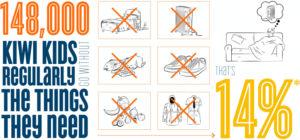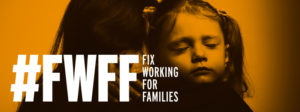 There is a grim reality to the latest poverty figures that should be seen as an outrage in our wealthy country. There are 155,000 children in material hardship, or 14% of all children, an increase in 10,000 from previous year. This group of children regularly miss out on the things they need like having enough to eat, especially fresh fruit and vegetables, having their own bed to sleep in, decent shoes, or adequate heating in their home.
There is a grim reality to the latest poverty figures that should be seen as an outrage in our wealthy country. There are 155,000 children in material hardship, or 14% of all children, an increase in 10,000 from previous year. This group of children regularly miss out on the things they need like having enough to eat, especially fresh fruit and vegetables, having their own bed to sleep in, decent shoes, or adequate heating in their home.
The group of children in hardship are stuck there for a long time. Some 85,000 of the children in hardship live in households with the lowest incomes and showing highest levels of material hardship, an increase on the previous year of 5,000. This is the group that the current government says it is most interested in helping. The one-off increase in welfare benefits from April 2016 is aimed at helping this group but in 2015, then Children’s Commissioner Russell Wills pointed out that government officials had calculated the increase of $25 per week would only be enough to make a small impact for those in deepest hardship, reducing numbers by around 10% or 10,000 fewer children in hardship. There is no sign of further steps to lift incomes for these children’s families.
 Research done that tracked the lives of families on low incomes shows that their situation is not changing enough to lift them out of poverty. Most of the families of those children stay in poverty and hardship for some time (e.g. up to 7 years) which is a huge chunk of a child’s life. This has lasting impacts on their ability to get ahead in life. Living in poor housing, not eating healthy food, and being sick more often affect the way a child’s brain develops, how well they do at school and their life chances long term.
Research done that tracked the lives of families on low incomes shows that their situation is not changing enough to lift them out of poverty. Most of the families of those children stay in poverty and hardship for some time (e.g. up to 7 years) which is a huge chunk of a child’s life. This has lasting impacts on their ability to get ahead in life. Living in poor housing, not eating healthy food, and being sick more often affect the way a child’s brain develops, how well they do at school and their life chances long term.
The new Childrens’ Commissioner, Andrew Becroft has challenged the Government to commit to a target of reducing children in hardship by 10% by the end of next year. When asked why he could set a target for making New Zealand predator-free but no goals for reducing child poverty, the Prime Minister responded that “it’s complicated”…
Lift Low Incomes and Fix Working for Families
The most effective solution to this is clear. Ensure that low income households get additional income – a child tax credit, allow more income to be earned before cutting back welfare assistance, and increase the minimum wage to help people get out of poverty when they find employment.
 A simple way to lift incomes would be to ‘Fix Working For Families‘, CPAG lastest proposal. Between 100,000 and 150,000 low income families, either on benefits, or not on benefits but failing the hours of work test, currently miss out on the In Work Tax Credit of at least $72.50 a week or $3770 a year. This would directly help those in deepest poverty directly and effectively.
A simple way to lift incomes would be to ‘Fix Working For Families‘, CPAG lastest proposal. Between 100,000 and 150,000 low income families, either on benefits, or not on benefits but failing the hours of work test, currently miss out on the In Work Tax Credit of at least $72.50 a week or $3770 a year. This would directly help those in deepest poverty directly and effectively.
